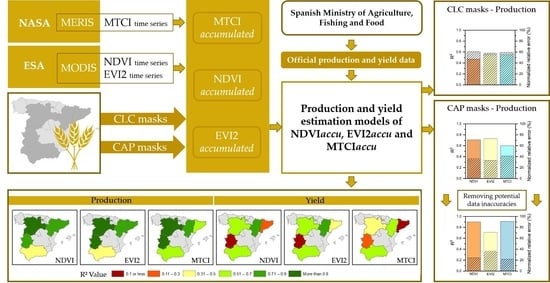Yield Estimation of Wheat Using Cropland Masks from European Common Agrarian Policy: Comparing the Performance of EVI2, NDVI, and MTCI in Spanish NUTS-2 Regions
Abstract
:1. Introduction
2. Materials and Methods
3. Results
3.1. Analysis of VIs’ Time Series
3.2. Analysis of Wheat Masks
3.3. Modeling Production and Yield
4. Discussion
5. Conclusions
Author Contributions
Funding
Data Availability Statement
Conflicts of Interest
References
- Duncan, J.M.A.; Dash, J.; Atkinson, P.M. Elucidating the impact of temperature variability and extremes on cereal croplands through remote sensing. Glob. Chang. Biol. 2015, 21, 1541–1551. [Google Scholar] [CrossRef] [PubMed]
- Shaw, D.J. World Food Summit 1996. In World Food Security; Palgrave Macmillan: London, UK, 2007. [Google Scholar] [CrossRef]
- Lucas, H. The Wheat Initiative—An International Research Initiative for Wheat Improvement. In Proceedings of the GCARD—Second Global Conference on Agricultural Research for Development, Punta del Este, Uruguay, 29 October–1 November 2012. [Google Scholar]
- FAOSTAT. Crops. Available online: http://www.fao.org/faostat/es/#data/QC (accessed on 13 September 2023).
- World Bank. Total Population. Available online: https://data.worldbank.org/indicator/SP.POP.TOTL?end=2019&start=1961 (accessed on 30 September 2021).
- Kumar, M. Impact of climate change on crop yield and role of model for achieving food security. Environ. Monit. Assess. 2016, 188, 465. [Google Scholar] [CrossRef] [PubMed]
- Lobell, D.B.; Schlenker, W.; Costa-Roberts, J. Climate Trends and Global Crop Production Since 1980. Science 2011, 333, 616–620. [Google Scholar] [CrossRef] [PubMed]
- Asseng, S.; Ewert, F.; Martre, P.; Rötter, R.P.; Lobell, D.B.; Cammarano, D.; Zhu, Y. Rising temperatures reduce global wheat production. Nat. Clim. Chang. 2014, 5, 143–147. [Google Scholar] [CrossRef]
- Gourdji, S.; Sibley, A.; Lobell, D. Global crop exposure to critical high temperatures in the reproductive period: Historical trends and future projections. Environ. Res. Lett. 2013, 8, 024041. [Google Scholar] [CrossRef]
- Kamir, E.; Waldner, F.; Hochman, Z. Estimating wheat yields in Australia using climate records, satellite image time series and machine learning methods. ISPRS J. Photogramm. 2020, 160, 124–135. [Google Scholar] [CrossRef]
- Dash, J.; Curran, P.J. Relationship between the MERIS Vegetation Indices and Crop Yield for the State of South Dakota, USA; European Space Agency (Special Publication) (SP-636); European Space Agency (ESA): Paris, France, 2007; pp. 1–6. [Google Scholar]
- Curtis, T.; Halford, N.G. Food security: The challenge of increasing wheat yield and the importance of not compromising food safety. Ann. Appl. Biol. 2014, 164, 354–372. [Google Scholar] [CrossRef]
- Atzberger, C. Advances in Remote Sensing of Agriculture: Context Description, Existing Operational Monitoring Systems and Major Information Needs. Remote Sens. 2013, 5, 949–981. [Google Scholar] [CrossRef]
- Becker-Reshef, I.; Justice, C.; Sullivan, M.; Vermote, E.; Tucker, C.; Anyamba, A.; Small, J.; Pak, E.; Masuoka, E.; Schmaltz, J.; et al. Monitoring Global Croplands with Coarse Resolution Earth Observations: The Global Agriculture Monitoring (GLAM) Project. Remote Sens. 2010, 2, 1589–1609. [Google Scholar] [CrossRef]
- FAO. GIEWS—Global Information and Early Warning System on Food and Agriculture. Available online: http://www.fao.org/giews/en/ (accessed on 13 September 2023).
- FAO. AquaCrop. Available online: http://www.fao.org/land-water/databases-and-software/aquacrop/en/ (accessed on 30 September 2021).
- Van der Velde, M.; Van Diepen, C.A. Editorial: The European crop monitoring and yield forecasting system: Celebrating 25 years of JRC MARS Bulletins. Agric. Syst. 2019, 168, 56–57. [Google Scholar] [CrossRef]
- Becker-Reshef, I.; Vermote, E.; Lindeman, M.; Justice, C. A generalized regression-based model for forecasting winter wheat yields in Kansas and Ukraine using MODIS data. Remote Sens. Environ. 2010, 114, 1312–1323. [Google Scholar] [CrossRef]
- Jégo, G.; Pattey, E.; Liu, J. Using Leaf Area Index, retrieved from optical imagery, in the STICS crop model for predicting yield and biomass of field crops. Field Crops Res. 2012, 131, 63–74. [Google Scholar] [CrossRef]
- Huang, Y.; Zhu, Y.; Li, W.L.; Cao, W.X.; Tian, Y.C. Assimilating remotely sensed information with the wheatgrow model based on the ensemble square root filter for improving regional wheat yield forecasts. Plant Prod. Sci. 2013, 16, 352–364. [Google Scholar] [CrossRef]
- Vazifedoust, M.; van Dam, J.C.; Bastiaanssen, W.G.M.; Feddes, R.A. Assimilation of satellite data into agrohydrological models to improve crop yield forecasts. Int. J. Remote Sens. 2009, 30, 2523–2545. [Google Scholar] [CrossRef]
- Dente, L.; Satalino, G.; Mattia, F.; Rinaldi, M. Assimilation of leaf area index derived from ASAR and MERIS data into CERES—Wheat model to map wheat yield. Remote Sens. Environ. 2008, 112, 1395–1407. [Google Scholar] [CrossRef]
- Huang, J.; Tian, L.; Liang, S.; Ma, H.; Becker-Reshef, I.; Huang, Y.; Wu, W. Improving winter wheat yield estimation by assimilation of the leaf area index from Landsat TM and MODIS data into the WOFOST model. Agric. For. Meteorol. 2015, 204, 106–121. [Google Scholar] [CrossRef]
- Huang, J.; Sedano, F.; Huang, Y.; Ma, H.; Li, X.; Liang, S.; Wu, W. Assimilating a synthetic Kalman filter leaf area index series into the WOFOST model to improve regional winter wheat yield estimation. Agric. For. Meteorol. 2016, 216, 188–202. [Google Scholar] [CrossRef]
- Kowalik, W.; Dabrowska-Zielinska, K.; Meroni, M.; Raczka, T.U.; de Wit, A. Yield estimation using SPOT-VEGETATION products: A case study of wheat in European countries. Int. J. Appl. Earth Obs. Geoinf. 2014, 32, 228–239. [Google Scholar] [CrossRef]
- Dong, J.; Lu, H.; Wang, Y.; Ye, T.; Yuan, W. Estimating winter wheat yield based on a light use efficiency model and wheat variety data. ISPRS J. Photogramm. 2020, 160, 18–32. [Google Scholar] [CrossRef]
- Wolanin, A.; Mateo-García, G.; Camps-Valls, G.; Gómez-Chova, L.; Meroni, M.; Duveiller, G.; Liangzhi, Y.; Guanter, L. Estimating and understanding crop yields with explainable deep learning in the Indian Wheat Belt Estimating and understanding crop yields with explainable deep learning in the Indian Wheat Belt. Environ. Res. Lett. 2020, 15, 024019. [Google Scholar] [CrossRef]
- Padilla, F.L.M.; Maas, S.J.; González-Dugo, M.P.; Mansilla, F.; Rajan, N.; Gavilán, P.; Domínguez, J. Monitoring regional wheat yield in Southern Spain using the GRAMI model and satellite imagery. Field Crops Res. 2012, 130, 145–154. [Google Scholar] [CrossRef]
- Atanasova, N.; Todorovski, L.; Džeroski, S.; Kompare, B. Application of automated model discovery from data and expert knowledge to a real-world domain: Lake Glumsø. Ecol. Model. 2008, 212, 92–98. [Google Scholar] [CrossRef]
- Rembold, F.; Atzberger, C.; Savin, I.; Rojas, O. Using Low Resolution Satellite Imagery for Yield Prediction and Yield Anomaly Detection. Remote Sens. 2013, 5, 1704–1733. [Google Scholar] [CrossRef]
- Johnson, M.D.; Hsieh, W.W.; Cannon, A.J.; Davidson, A.; Bédard, F. Crop Yield forecasting on the canadian prairies by remotely sensed vegetation indices and machine learning methods. Agric. For. Meteorol. 2016, 218–219, 74–84. [Google Scholar] [CrossRef]
- Dempewolf, J.; Adusei, B.; Becker-Reshef, I.; Hansen, M.; Potapov, P.; Khan, A.; Barker, B. Wheat yield forecasting for Punjab Province from vegetation index time series and historic crop statistics. Remote Sens. 2014, 6, 9653–9675. [Google Scholar] [CrossRef]
- Roman, L.J.; Calle, A.; Delgado, J.A. Modelos de estimación de cosechas de cereal basados en imágenes de satélite y datos meteorológicos. In Proceedings of the Teledetección y Desarrollo Regional. X Congreso de Teledetección, Cáceres, Spain, 17–19 September 2003. [Google Scholar]
- Calvo Polanco, M.; Silva Pando, F.J.; Rozados Lorenzo, M.J.; Díaz Blanco, M.; Rodríguez Dorriba, P.; Duo Suárez, I. El índice de área foliar (LAI) en masas de abedul (Betula celtiberica rothm. et vasc.) en Galicia. Cuad. Soc. Española Cienc. For. 2005, 20, 111–116. [Google Scholar]
- Haboudane, D.; Miller, J.R.; Pattey, E.; Zarco-Tejada, P.J.; Strachan, I.B. Hyperspectral vegetation indices and novel algorithms for predicting green LAI of crop canopies: Modeling and validation in the context of precision agriculture. Remote Sens. Environ. 2004, 90, 337–352. [Google Scholar] [CrossRef]
- Ocampo, D.; Rivas, R.; Carmona, F.; Figueredo, H.; Palazzani, L. Estimación de rendimiento de trigo por ambientes a partir de datos del sensor Thematic Mapper. In Teledetección: Recientes Aplicaciones en la Región Pampeana; Rivas, R., Carmona, F., Ocampo, D., Eds.; Martin: Buenos Aires, Argentina, 2011; pp. 115–125. [Google Scholar]
- Boken, V.K.; Shaykewich, C.F. Improving an operational wheat yield model using phenological phase-based Normalized Difference Vegetation Index. Int. J. Remote Sens. 2002, 23, 4155–4168. [Google Scholar] [CrossRef]
- Moges, M.; Raun, W.; Mullen, R.; Freeman, K.; Johnson, G.; Solie, J. Evaluation of Green, Red, and Near Infrared Bands for Predicting Winter Wheat Biomass, Nitrogen Uptake, and Final Grain Yield. J. Plant Nutr. 2004, 27, 1431–1441. [Google Scholar] [CrossRef]
- Moriondo, M.; Maselli, F.; Bindi, M. A simple model of regional wheat yield based on NDVI data. Eur. J. Agron. 2007, 26, 266–274. [Google Scholar] [CrossRef]
- Zhu, J.; Yin, Y.; Lu, J.; Warner, T.A.; Xu, X.; Lyu, M.; Wang, X.; Guo, C.; Cheng, T.; Zhu, Y.; et al. The relationship between wheat yield and sun-induced chlorophyll fluorescence from continuous measurements over the growing season. Remote Sens. Environ. 2023, 298, 113791. [Google Scholar] [CrossRef]
- Zhang, S.; Liu, L. The potential of the MERIS Terrestrial Chlorophyll Index for crop yield prediction. Remote Sens. Lett. 2014, 5, 733–742. [Google Scholar] [CrossRef]
- Bouras, E.H.; Olsson, P.O.; Thapa, S.; Mallol-Diaz, J.; Albertsson, J.; Eklundh, L. Wheat Yield Estimation at High Spatial Resolution through the Assimilation of Sentinel-2 Data into a Crop Growth Model. Remote Sens. 2023, 15, 4425. [Google Scholar] [CrossRef]
- Ashourloo, D.; Manafiard, M.; Behifar, M.; Kohandel, M. Wheat yield prediction based on Sentinel-2, regression and machine learning models in Hamdan, Iran. Sci. Iran. 2022, 29, 3230–3243. [Google Scholar] [CrossRef]
- Caparros-Santiago, J.A.; Rodriguez-Galiano, V.; Dash, J. Land surface phenology as indicator of global terrestrial ecosystem dynamics: A systematic review. ISPRS J. Photogramm. 2021, 171, 330–347. [Google Scholar] [CrossRef]
- Matsushita, B.; Yang, W.; Chen, J.; Onda, Y.; Qiu, G. Sensitivity of the Enhanced Vegetation Index (EVI) and Normalized Difference Vegetation Index (NDVI) to topographic effects: A case study in high-density cypress forest. Sensors 2007, 7, 2636–2651. [Google Scholar] [CrossRef]
- Wardlow, B.D.; Egbert, S.L.; Kastens, J.H. Analysis of time-series MODIS 250m vegetation index data for crop classification in the U.S. Central Great Plains. Remote Sens. Environ. 2007, 108, 290–310. [Google Scholar] [CrossRef]
- Gao, X.; Huete, A.R.; Ni, W.; Miura, W. Optical-biophysical relationships of vegetation spectra without background contamination. Remote Sens. Environ. 2000, 74, 609–620. [Google Scholar] [CrossRef]
- Claverie, M.; Ju, J.; Masek, J.G.; Dungan, J.L.; Vermote, E.F.; Roger, J.; Skakun, S.; Justice, C. The Harmonized Landsat and Sentinel-2 surface reflectance data set. Remote Sens. Environ. 2018, 219, 145–161. [Google Scholar] [CrossRef]
- Büttner, G.; Feranec, J.; Jaffrain, G.; Mari, L.; Maucha, G.; Soukup, T. The CORINE land cover 2000 project. EARSeL eProc. 2004, 3, 331–346. [Google Scholar]
- Iglesias, A.; Garrote, L.; Quiroga, S.; Moneo, M. A regional comparison of the effects of climate change on agricultural crops in Europe. Clim. Chang. 2012, 112, 29–46. [Google Scholar] [CrossRef]
- Baret, F.; Morisette, J.; Fernandes, R.A.; Champeaux, J.L.; Myneni, R.B.; Chen, J.; Plummer, S.; Weiss, M.; Bacour, C.; Garrigues, S.; et al. Evaluation of the representativeness of networks of sites for the global validation and intercomparison of land biophysical products: Proposition of the CEOS-BELMANIP. IEEE Trans. Geosci. Remote Sens. 2006, 44, 1794–1803. [Google Scholar] [CrossRef]
- Baret, F.; Weiss, M.; Lacaze, R.; Camacho, F.; Makhmara, H.; Pacholczyk, P.; Smets, B. GEOV1: LAI, FAPAR essential climate variables and FCOVER global time series capitalizing over existing products. Part 1: Principles of development and production. Remote Sens. Environ. 2013, 137, 299–309. [Google Scholar] [CrossRef]
- Büttner, G.; Kosztra, B.; Maucha, G.; Pataki, R.; Kleeschulte, S.; Hazeu, G.; Vittek, M.; Schröder, C.; Littkopf, A. CORINE Land Cover—Copernicus Land Monitoring Service User Manual; Copernicus Publications: Bonn, Germany, 2021. [Google Scholar]
- Spanish Ministry of Agriculture, Fisheries and Food. Avances de Superficies y Producciones de Cultivos de Diciembre de 2020. Available online: https://www.mapa.gob.es/es/estadistica/temas/estadisticas-agrarias/cuaderno_diciembre2020_tcm30-558173.pdf (accessed on 30 September 2021).
- Vermote, E. MOD09Q1 MODIS/Terra Surface Reflectance 8-Day L3 Global 250m SIN Grid V006; Distributed by NASA EOSDIS Land Processes DAAC; NASA EOSDIS Land Processes DAAC: Missoula, MT, USA, 2015. [CrossRef]
- European Space Agency. MERIS Full Resolution L2 Product 4th Reprocessing. Available online: https://doi.org/10.5270/EN1-vqoj1gs (accessed on 13 September 2023).
- Rouse, J.W.; Haas, R.H.; ScheU, J.A.; Deering, D.W. Monitoring vegetation systems in the Great Plains with ERTS. In Third ERTS Symposium; NASA SP-351 I; NASA Special Publication: Washington, DC, USA, 1973; pp. 309–317. [Google Scholar]
- Jiang, Z.; Huete, A.R.; Didan, K.; Miura, T. Development of a two-band enhanced vegetation index without a blue band. Remote Sens. Environ. 2008, 112, 3833–3845. [Google Scholar] [CrossRef]
- Dash, J.; Jeganathan, C.; Atkinson, P.M. The use of MERIS Terrestrial Chlorophyll Index to study spatio-temporal variation in vegetation phenology over India. Remote Sens. Environ. 2010, 114, 1388–1402. [Google Scholar] [CrossRef]
- Atkinson, P.M.; Jeganathan, C.; Dash, J.; Atzberger, C. Inter-comparison of four models for smoothing satellite sensor time-series data to estimate vegetation phenology. Remote Sens. Environ. 2012, 123, 400–417. [Google Scholar] [CrossRef]
- Funk, C.; Budde, M.E. Phenologically-tuned MODIS NDVI-based production anomaly estimates for Zimbabwe. Remote Sens. Environ. 2009, 113, 115–125. [Google Scholar] [CrossRef]
- Teixeira, E.I.; Fischer, G.; van Velthuizen, H.; Walter, C.; Ewert, F. Global hot-spots of heat stress on agricultural crops due to climate change. Agric. For. Meteorol. 2013, 170, 206–215. [Google Scholar] [CrossRef]
- Egea-Cobrero, V.; Rodriguez-Galiano, V.; Sanchez-Rodriguez, E.; Garcia-Perez, M.A. Estimación de la cosecha de trigo en Andalucía usando series temporales de MERIS Terrestrial Chlorophyll Index (MTCI). Rev. Teledetec. 2018, 51, 99–112. [Google Scholar] [CrossRef]
- Willmott, C.J.; Matsuura, K. Advantages of the Mean Absolute Error (MAE) over the Root Mean Square Error (RMSE) in Assessing Average Model Performance. Clim. Res. 2005, 30, 79–82. Available online: http://www.jstor.org/stable/24869236 (accessed on 27 September 2023). [CrossRef]
- Mkhabela, M.S.; Bullock, P.; Raj, S.; Wang, S.; Yang, Y. Crop yield forecasting on the Canadian Prairies using MODIS NDVI data. Agric. For. Meteorol. 2011, 151, 385–393. [Google Scholar] [CrossRef]
- Lopez Bellido, L. Cultivos Herbáceos; Mundi-Prensa: Madrid, Spain, 1991. [Google Scholar]
- Nguy-Robertson, A.; Gitelson, A.; Peng, Y.; Viña, A.; Arkebauer, T.; Rundquist, D. Green Leaf Area Index Estimation in Maize and Soybean: Combining Vegetation Indices to Achieve Maximal Sensitivity. Agron. J. 2012, 104, 1336–1347. [Google Scholar] [CrossRef]
- Broge, N.H.; Leblanc, E. Comparing Prediction Power and Stability of Broadband and Hyperspectral Vegetation Indices for Estimation of Green Leaf Area Index and Canopy Chlorophyll Density. Remote Sens. Environ. 2001, 76, 156–172. [Google Scholar] [CrossRef]
- Rondeaux, G.; Steven, M.; Baret, F. Optimization of Soil-Adjusted Vegetation Indices. Remote Sens. Environ. 1996, 55, 95–107. [Google Scholar] [CrossRef]
- Huete, A.; Didan, K.; Miura, H.; Rodriguez, E.P.; Gao, X.; Ferreira, L.F. Overview of the radiometric and biopyhsical performance of the MODIS vegetation indices. Remote Sens. Environ. 2002, 83, 195–213. [Google Scholar] [CrossRef]
- Dash, J.; Curran, P.J. The MERIS terrestrial chlorophyll index. Int. J. Remote Sens. 2004, 25, 5403–5413. [Google Scholar] [CrossRef]
- Löw, F.; Biradar, C.; Dubovyk, O.; Fliemann, E.; Akramkhanov, A.; Narvaez Vallejo, A.; Waldner, F. Regional-scale monitoring of cropland intensity and productivity with multi-source satellite image time series. GISci. Remote Sens. 2018, 55, 539–567. [Google Scholar] [CrossRef]
- Kogan, F.; Kussul, N.; Adamenko, T.; Skakun, S.; Kravchenko, O.; Kryvobok, O.; Shelestov, A.; Kolotii, A.; Kussul, O.; Lavrenyuk, A. Winter wheat yield forecasting in Ukraine based on Earth observation, meteorological data and biophysical models. Int. J. Appl. Earth Obs. Geoinf. 2013, 23, 193–203. [Google Scholar] [CrossRef]
- Vicente-Serrano, S.M.; Cuadrat, J.M.; Romo, A. Early prediction of crop productions using drought indices at different time scales and remote sensing data: Application in the Ebro valley (North-east Spain). Int. J. Remote Sens. 2006, 27, 511–518. [Google Scholar] [CrossRef]
- Hill, M.J.; Donald, G.E. Estimating Spatio-Temporal Patterns of Agricultural Productivity in Fragmented Landscapes Using AVHRR NDVI Time Series. Remote Sens. Environ. 2003, 84, 367–384. [Google Scholar] [CrossRef]
- Iglesias, A.; Rosenzweig, C.; Pereira, D. Agricultural impacts of climate in Spain: Developing tools for a spatial analysis. Glob. Environ. Chang. 2000, 10, 69–80. [Google Scholar] [CrossRef]
- Instituto Tecnológico Agrario de Castilla y León. Boletín de Predicción de Cosechas de Castilla y León: Metodología. Available online: http://cosechas.itacyl.es/en/metodologia (accessed on 6 May 2023).
- Weiss, M.; Jacob, F.; Duveiller, G. Remote sensing for agricultural applications: A meta-review. Remote Sens. Environ. 2020, 236, 111402. [Google Scholar] [CrossRef]
- EUROSTAT. Crop Production. Available online: https://ec.europa.eu/eurostat/cache/metadata/EN/apro_cp_esqrs.htm (accessed on 7 May 2023).
- Baruth, B.; Royer, A.; Klisch, A.; Genovese, G. The use of remote sensing within the MARS crop yield monitoring system of the European Commission. Int. Arch. Photogramm. Remote Sens. Spat. Inf. Sci. 2008, 37, 935–940. Available online: http://www.isprs.org/proceedings/XXXVII/congress/8_pdf/10_WG-VIII-10/02.pdf (accessed on 27 September 2023).
- Townshend, J.R.G.; Justice, C.O. Selecting the spatial resolution of satellite sensors required for global monitoring of land transformations. Int. J. Remote Sens. 1988, 9, 187–236. [Google Scholar] [CrossRef]
- Zhan, X.; Sohlberg, R.A.; Townshend, J.R.G.; DiMiceli, C.; Carroll, M.L.; Eastman, J.C.; Hansen, M.C.; DeFries, R.S. Detection of land cover changes using MODIS 250 m data. Remote Sens. Environ. 2002, 83, 336–350. [Google Scholar] [CrossRef]
- Nigam, R.; Vyas, S.; Bhattacharya, B.; Oza, M.; Srivastava, S.; Bhagia, N.; Dhar, D.; Manjunath, K. Modeling temporal growth profile of vegetation index from Indian geostationary satellite for assessing in-season progress of crop area. GISci. Remote Sens. 2015, 52, 723–745. [Google Scholar] [CrossRef]
- Turner II, B.L.; Skole, D.; Sanderson, S.; Fischer, G.; Fresco, L.; Leemans, R. Land-Use and Land-Cover Change Science/Research Plan. IGBP Report No. 35 and HDP Report 1995 No. 7. Available online: http://pure.iiasa.ac.at/4402 (accessed on 27 September 2023).
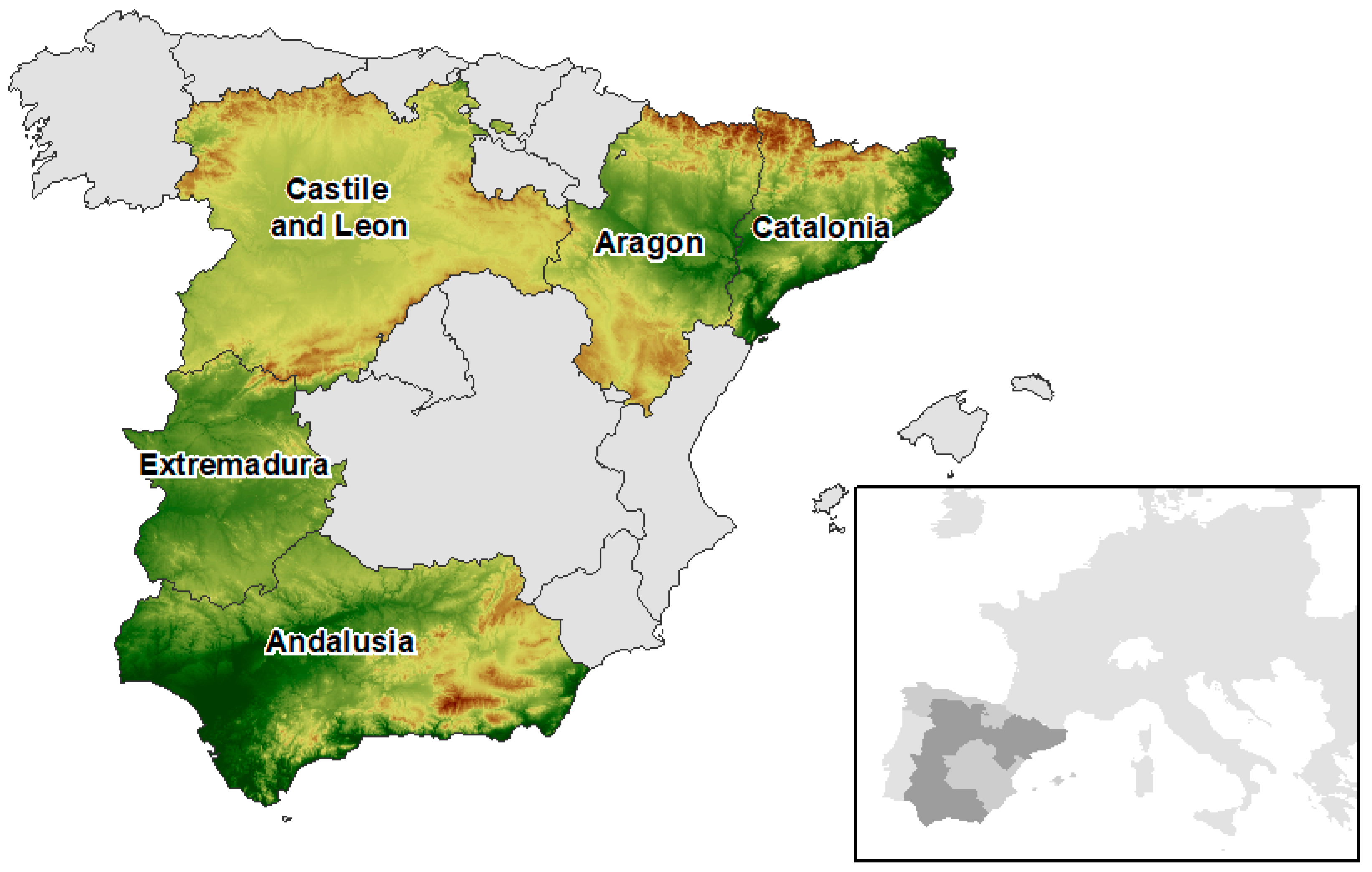

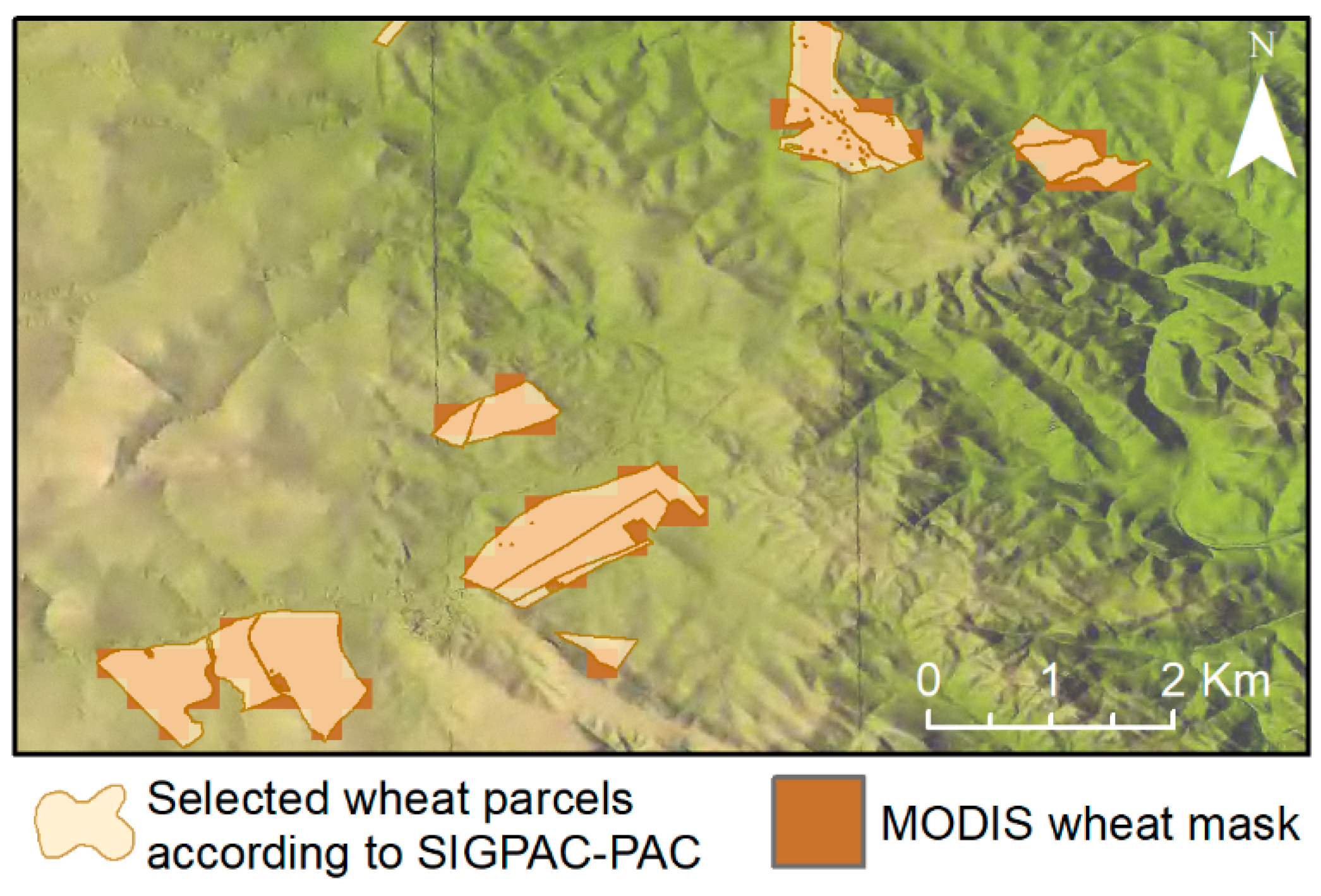

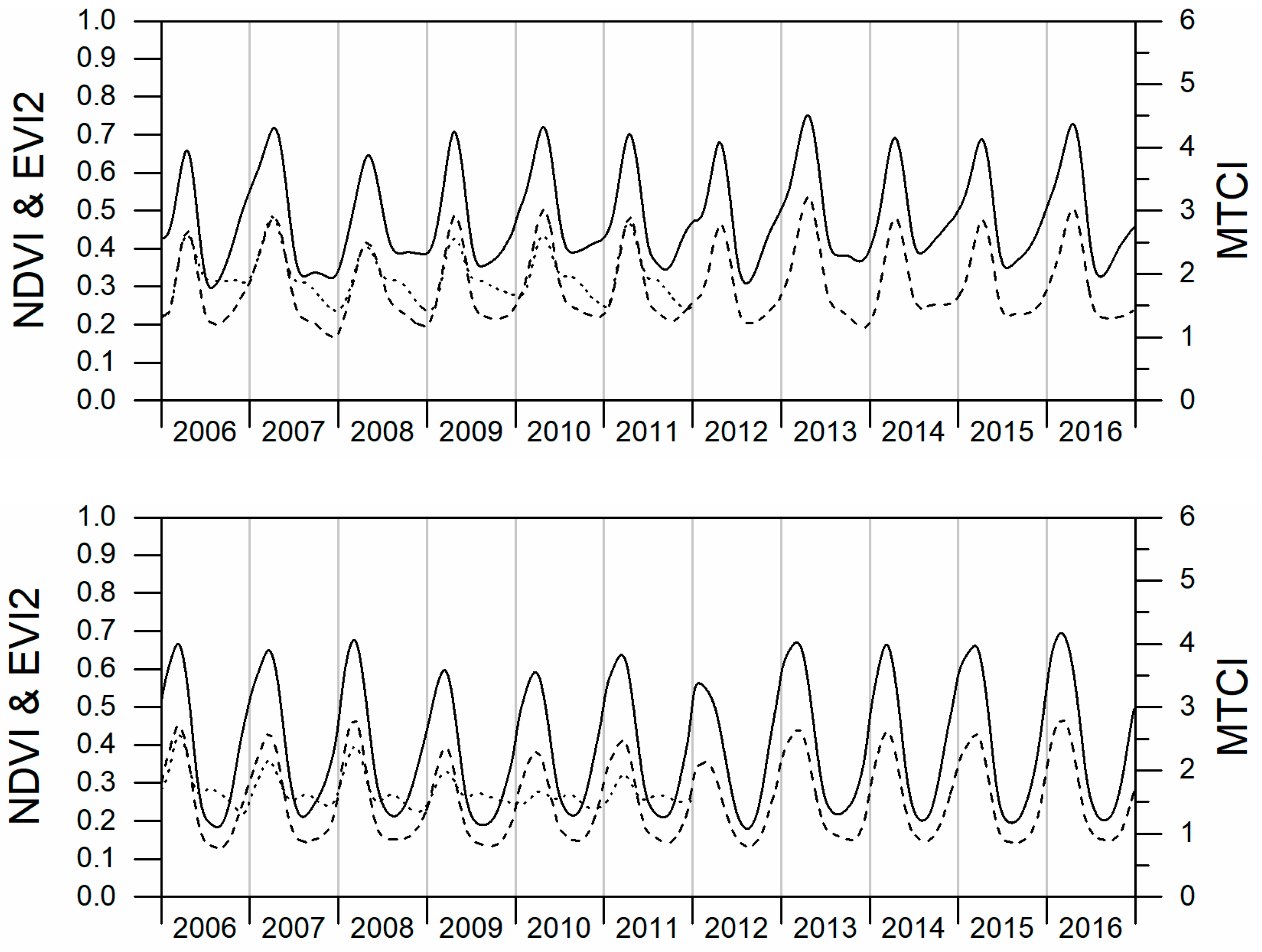
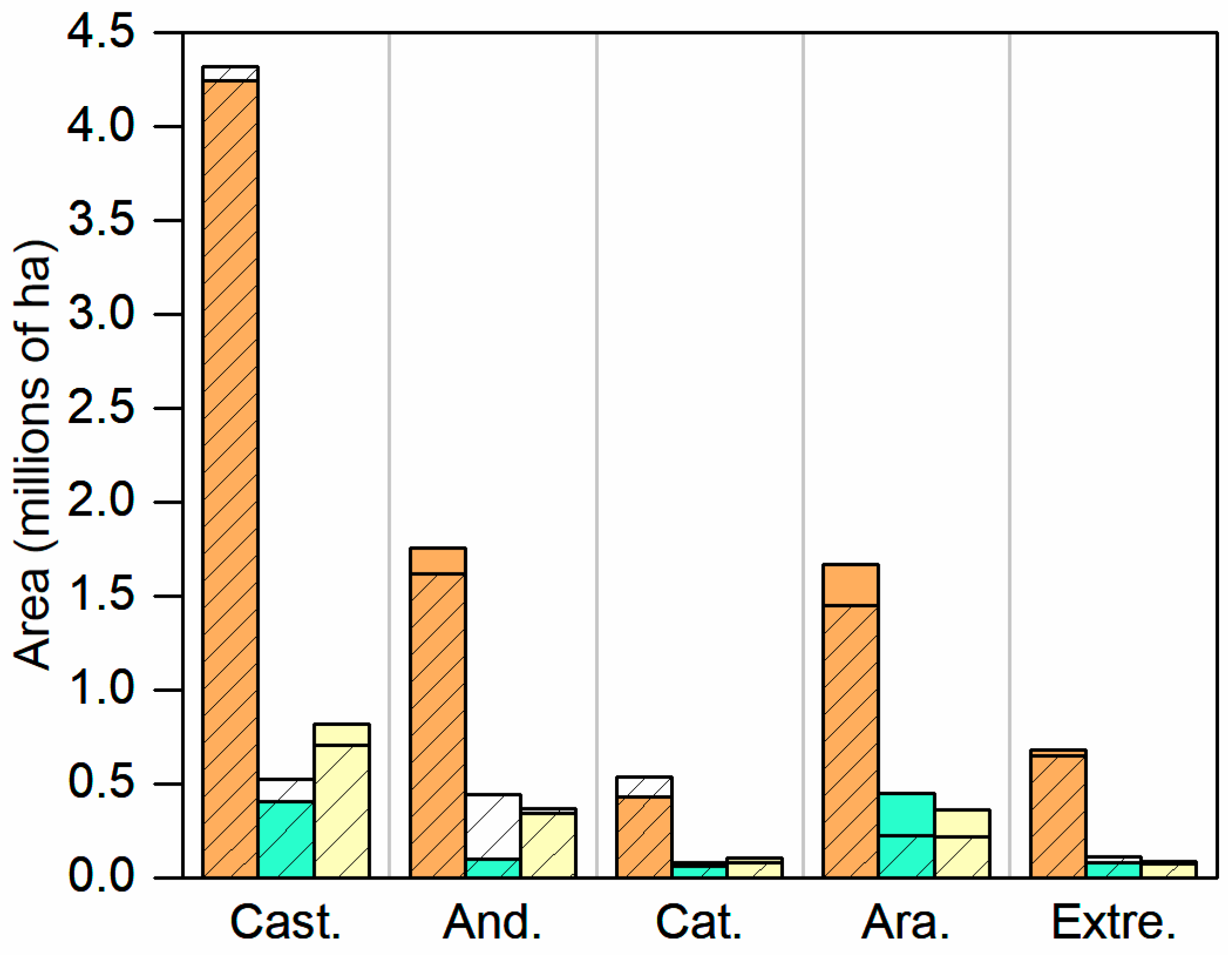
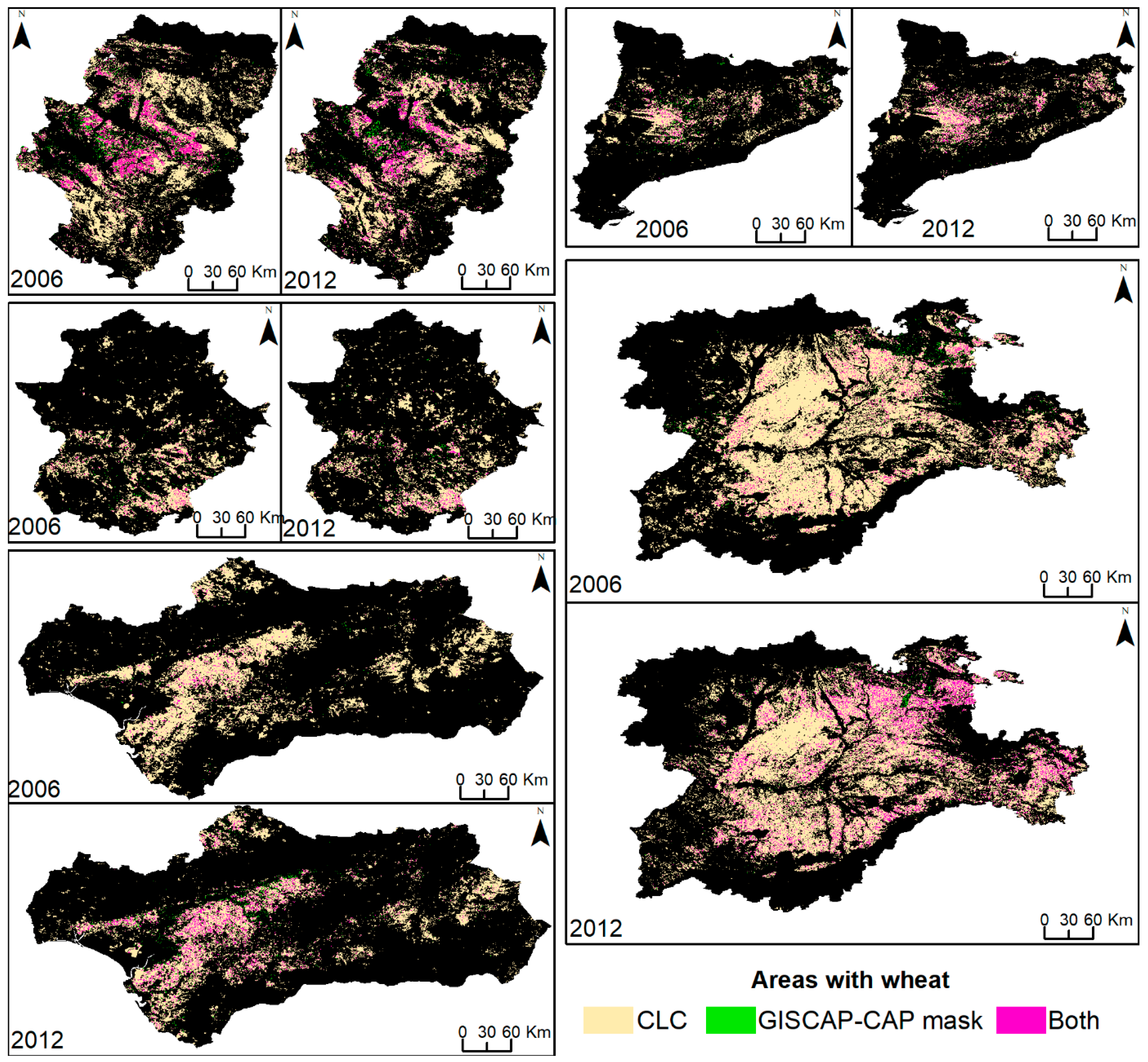
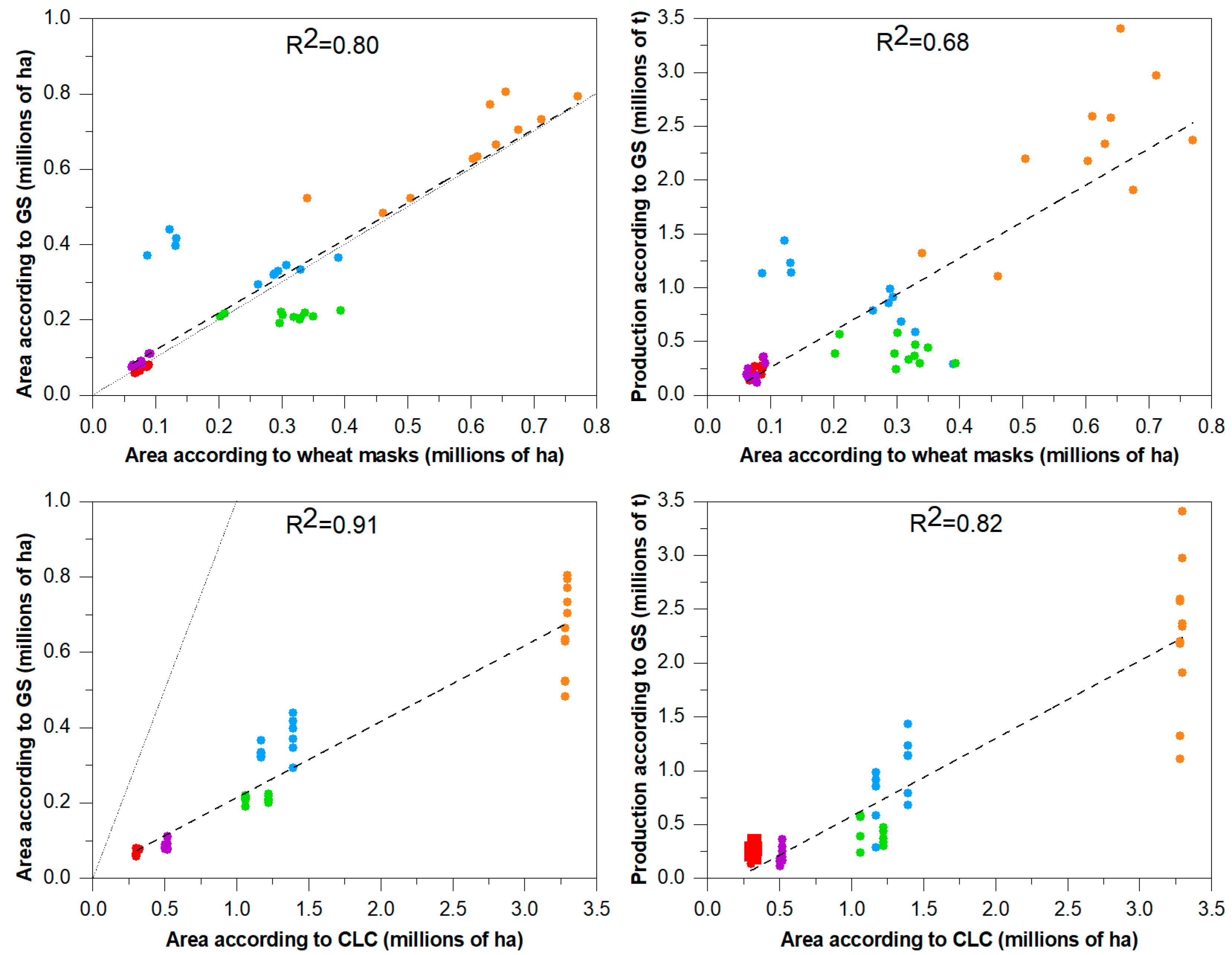
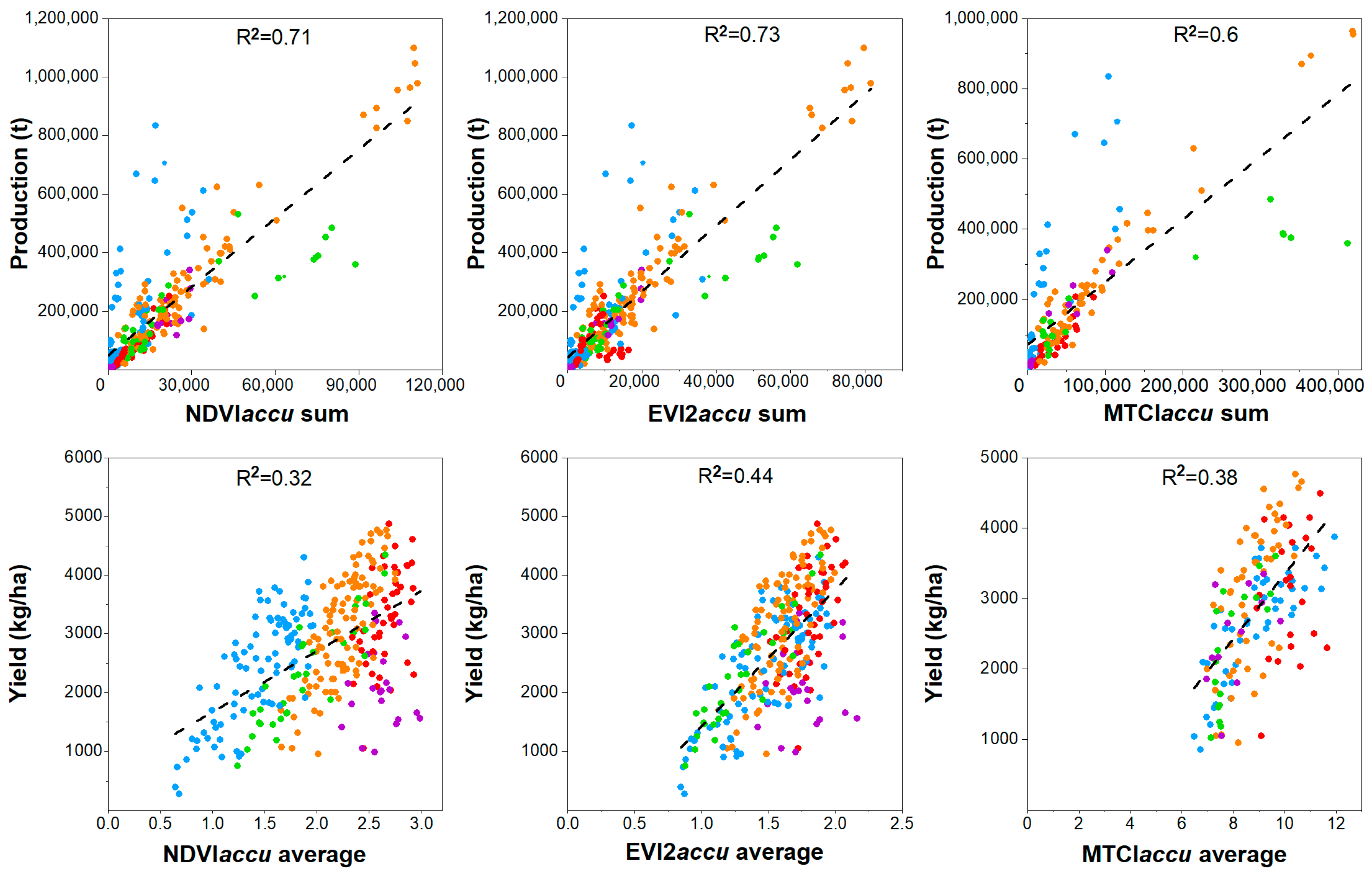
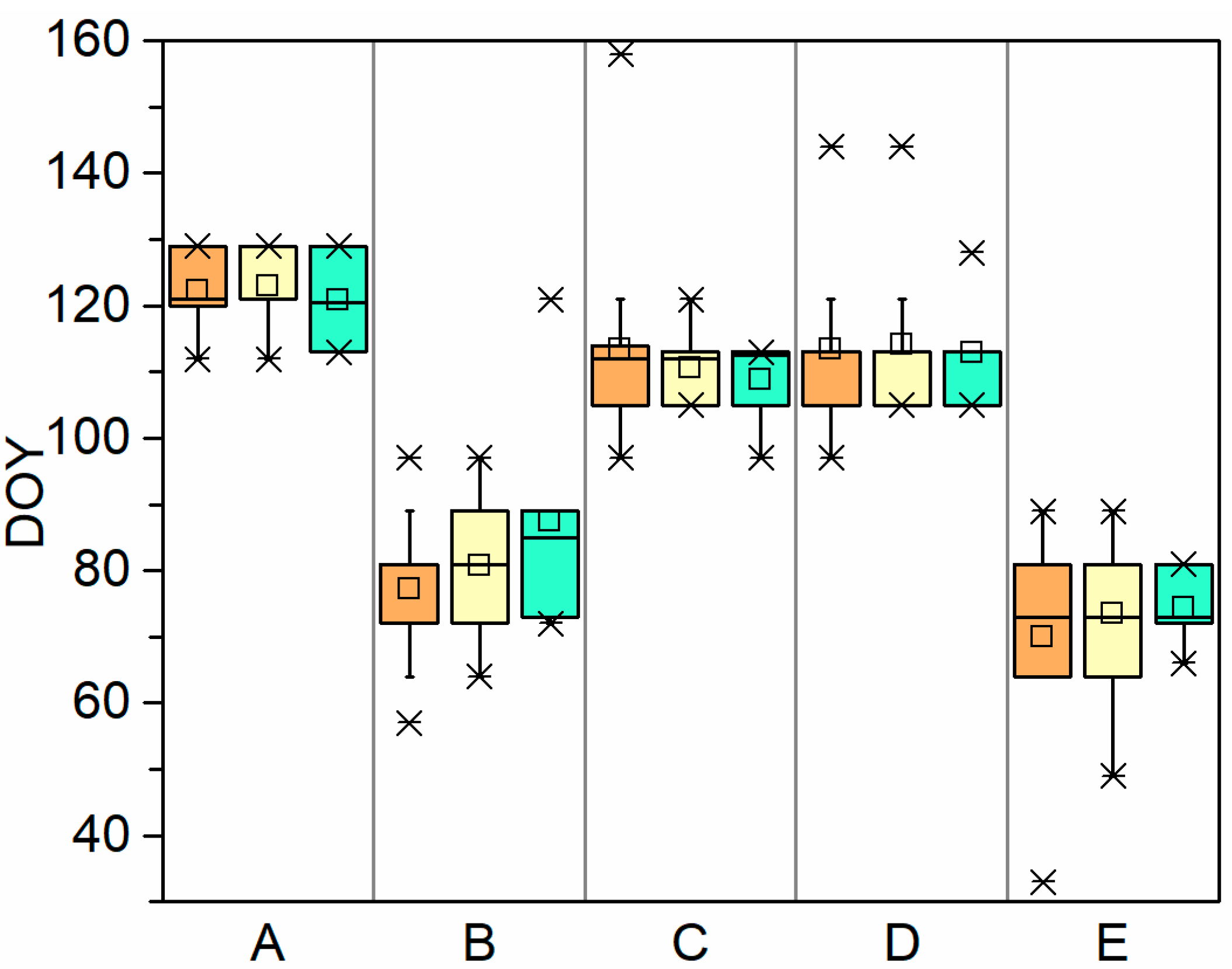
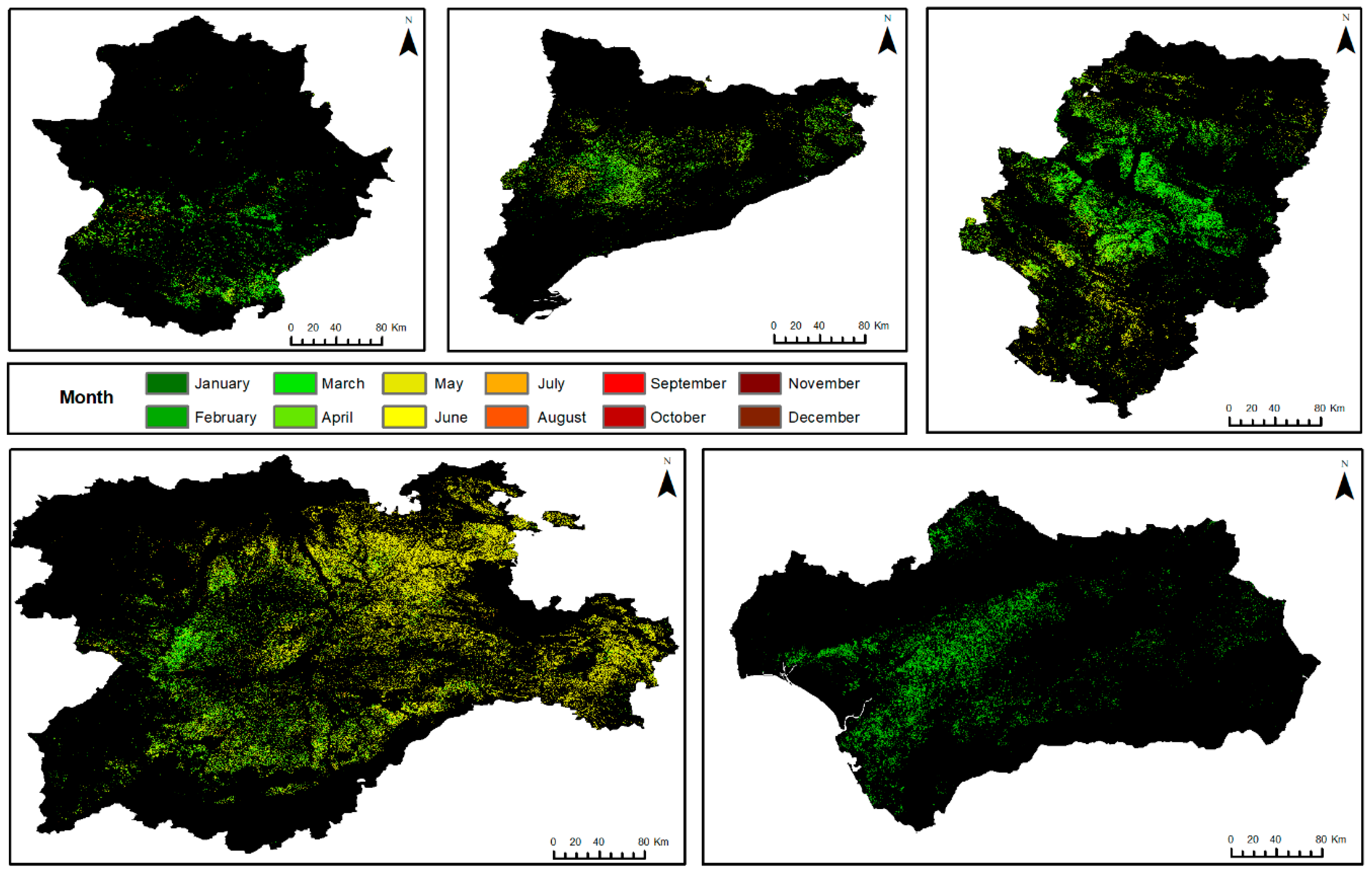
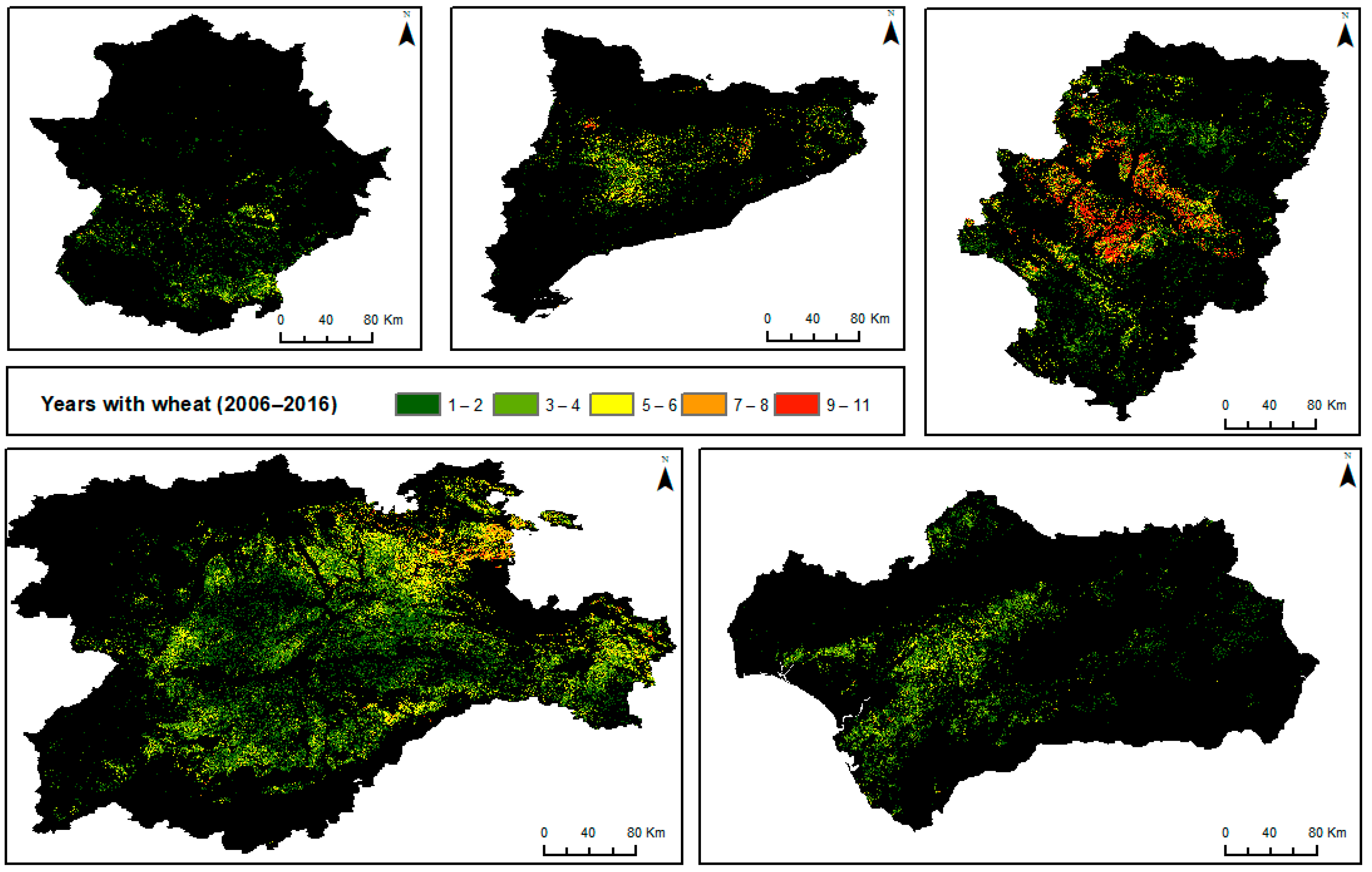


| Mean Wheat Parcel Size (ha) | Standard Deviation of Wheat Parcel Size (ha) | Number of MODIS Pixels | MODIS Pixel Area (km2) | Number of MERIS Pixel | MERIS Pixel Area (km2) | |
|---|---|---|---|---|---|---|
| Andalusia | 13.4 | 15.9 | 22,737.2 | 1421.1 | 20,543.3 | 1848.9 |
| Aragon | 8.9 | 8.9 | 59,288.3 | 3705.5 | 50,929.2 | 4583.6 |
| Castile and Leon | 7.3 | 5.6 | 98,681 | 6167.6 | 91,323.5 | 8219.1 |
| Catalonia | 7.1 | 4.2 | 13,670.7 | 854.4 | 13,224.5 | 1190.2 |
| Extremadura | 11.8 | 13.2 | 8660.8 | 541.3 | 8433.8 | 759 |
| NDVI (DOY) | EVI2 (DOY) | MTCI (DOY) | |
|---|---|---|---|
| Andalusia | 40–136 | 40–136 | 40–136 |
| Aragon | 40–216 | 24–208 | 16–192 |
| Castile and Leon | 32–232 | 72–208 | 8–200 |
| Catalonia | 8–176 | 24–192 | 48–192 |
| Extremadura | 8–176 | 8–152 | 16–144 |
| Castile and Leon | Andalusia | Catalonia | Aragon | Extremadura | Total | ||
|---|---|---|---|---|---|---|---|
| 2006 | GISCAP-CAP | 76.83% | 21.83% | 138.97% | 199.79% | 69.94% | 88.57% |
| CLC | 811.19% | 398.86% | 738.93% | 746% | 618.00% | 704.98% | |
| 2012 | GISCAP-CAP | 116.28% | 93.84% | 135.19% | 163.43% | 87.97% | 117.18% |
| CLC | 613.60% | 442.54% | 692.07% | 656.52% | 778.56% | 590.71% |
| R2 | NRE | |||||
|---|---|---|---|---|---|---|
| NDVI | EVI2 | MTCI | NDVI | EVI2 | MTCI | |
| Andalusia | 0.47 * | 0.47 * | 0.68 * | 54.63% | 52.79% | 49.35% |
| Aragon | 0.77 * | 0.78 * | 0.86 * | 25.29% | 23.53% | 17.63% |
| Castile and Leon | 0.96 * | 0.96 * | 0.98 * | 17.71% | 17.88% | 14.72% |
| Catalonia | 0.82 * | 0.84 * | 0.69 * | 14.43% | 13.33% | 20.40% |
| Extremadura | 0.85 * | 0.94 * | 0.92 * | 24.92% | 24.68% | 22.37% |
| Total | 0.71 * | 0.75 * | 0.6 * | 36.71% | 32.99% | 41.07% |
| R2 | NRE | |||||
|---|---|---|---|---|---|---|
| NDVI | EVI2 | MTCI | NDVI | EVI2 | MTCI | |
| Andalusia | 0.56 * (0.61) | 0.54 * (0.59) | 0.61 * (0.66) | 18.86% (19.16%) | 19.55% (19.83%) | 13.74% (14.17%) |
| Aragon | 0.81 * (0.78) | 0.81 * (0.85) | 0.57 * (0.59) | 13.04% (11.21%) | 10.57% (10.57%) | 13.12% (13.11%) |
| Castile and Leon | 0.59 * (0.41) | 0.51 * (0.3) | 0.44 * (0.25) | 17.47% (17.43%) | 18.94% (18.97%) | 19.95% (19.83%) |
| Catalonia | 0.25 * (0.26) | 0.31 * (0.39) | 0.06 (0.1) | 13.04% (13.19%) | 12.75% (13.11%) | 18.76% (18.73%) |
| Extremadura | 0.01 (0.01) | 0.02 (0.01) | 0.26 (0.25) | 24.54% (24.48%) | 24.44% (24.31%) | 16.43% (16.37%) |
| Total | 0.38 * (0.36) | 0.44 * (0.38) | 0.37 * (0.32) | 22.76% (22.79%) | 21.88% (22.20%) | 21.23% (20.94%) |
| R2 | NRE | ||||
|---|---|---|---|---|---|
| Production | Yield | Production | Yield | ||
| NDVI | 2006 | 0.31 * | 0.05 | 68.01% | 25.98% |
| 2012 | 0.67 * | 0.59 * | 55.51% | 22.81% | |
| Both | 0.47 * | 0.33 * | 60.71% | 27.20% | |
| EVI2 | 2006 | 0.44 * | 0.45 * | 62.39% | 20.65% |
| 2012 | 0.69 * | 0.53 * | 55.01% | 23.65% | |
| Both | 0.55 * | 0.51 * | 58.01% | 22.34% | |
| MTCI | 2006 | 0.55 * | 0.55 * | 59.38% | 17.70% |
| Andalusia | Aragon | Castile and Leon | Catalonia | Extremadura | |
|---|---|---|---|---|---|
| Mean altitude | 248.26 | 526.86 | 872.23 | 530.91 | 424.25 |
| Lowest altitude | 1 | 120 | 377 | 1 | 149 |
| Highest altitude | 1911 | 1815 | 1485 | 1649 | 684 |
Disclaimer/Publisher’s Note: The statements, opinions and data contained in all publications are solely those of the individual author(s) and contributor(s) and not of MDPI and/or the editor(s). MDPI and/or the editor(s) disclaim responsibility for any injury to people or property resulting from any ideas, methods, instructions or products referred to in the content. |
© 2023 by the authors. Licensee MDPI, Basel, Switzerland. This article is an open access article distributed under the terms and conditions of the Creative Commons Attribution (CC BY) license (https://creativecommons.org/licenses/by/4.0/).
Share and Cite
Garcia-Perez, M.A.; Rodriguez-Galiano, V.; Sanchez-Rodriguez, E.; Egea-Cobrero, V. Yield Estimation of Wheat Using Cropland Masks from European Common Agrarian Policy: Comparing the Performance of EVI2, NDVI, and MTCI in Spanish NUTS-2 Regions. Remote Sens. 2023, 15, 5423. https://doi.org/10.3390/rs15225423
Garcia-Perez MA, Rodriguez-Galiano V, Sanchez-Rodriguez E, Egea-Cobrero V. Yield Estimation of Wheat Using Cropland Masks from European Common Agrarian Policy: Comparing the Performance of EVI2, NDVI, and MTCI in Spanish NUTS-2 Regions. Remote Sensing. 2023; 15(22):5423. https://doi.org/10.3390/rs15225423
Chicago/Turabian StyleGarcia-Perez, M. A., V. Rodriguez-Galiano, E. Sanchez-Rodriguez, and V. Egea-Cobrero. 2023. "Yield Estimation of Wheat Using Cropland Masks from European Common Agrarian Policy: Comparing the Performance of EVI2, NDVI, and MTCI in Spanish NUTS-2 Regions" Remote Sensing 15, no. 22: 5423. https://doi.org/10.3390/rs15225423
APA StyleGarcia-Perez, M. A., Rodriguez-Galiano, V., Sanchez-Rodriguez, E., & Egea-Cobrero, V. (2023). Yield Estimation of Wheat Using Cropland Masks from European Common Agrarian Policy: Comparing the Performance of EVI2, NDVI, and MTCI in Spanish NUTS-2 Regions. Remote Sensing, 15(22), 5423. https://doi.org/10.3390/rs15225423






